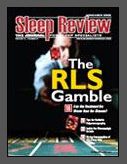

The Pillar Implant Procedure: Does It Work?
The Pillar Implant procedure is an obstructive sleep apnea (OSA) treatment option that has been around for several years but has more recently received a significant amount of publicity. The procedure is a form of oropharyngeal surgery involving the placement of three polyester implants in the soft palate under local anesthesia during a single-stage office procedure.

RLS and Compulsive Gambling
Restless legs syndrome is a neurological disorder characterized by the urge to move the legs, which is partially but temporarily relieved by movement. Patients may have a worsening of symptoms at rest and in the evening and, as a consequence, sleep disturbances. Restless legs syndrome is common and may affect 10% of the population.

Getting Smarter While You Sleep
The history of research that sleep contributes to the consolidation of memory began in 1885. In 1914, and again in 1924, other similar studies confirmed that nonsense syllables learned just before going to bed were more likely to be remembered the following day after a period of sleep than when a similar time period of wakefulness occurred between learning and recall.

Sleep and Memory: Can Learning Be Enhanced?
The history of sleep and memory research began with Ebbinghaus in 1885. Research remained dormant for some time, but by the late 1980s, studies involving trampolining (Percept. Mot. Skills 1988;6:635-45), intensive study of a foreign language (Int. J. Psychophysiol. 1989;8:43-7), and learning Morse code (Physiol. Behav. 1989;46:639-42) all demonstrated increases in REM sleep following successful learning.

Can Dreaming Unfreeze Parkinson’s Disease?
Parkinson’s disease has become better known to the general public through awareness of the disease in famous people such as Michael J. Fox. Parkinson’s disease is a progressive neurodegenerative disorder of the central nervous system characterized by a loss of dopaminergic neurons in the substantia nigra in the midbrain.

Book Reivew – REM Illumination: Memory Consolidation
Reviewed by Gina R. Poe, PhD
TIM WALTER OFFERS A CONCISE, DIGESTIBLE SYNTHESIS OF DECADES OF WORK ON SLEEP AND MEMORY, MAKING REM ILLUMINATION A MUST-READ FOR those in the field and those interested in it. Experts will pick up tidbits of information they did not know or had not put together, such as the fact that two big events that seeded the field of sleep and memory occurred the same year, 1953, when patient H. M. underwent his historic memory-altering bilateral hippocampal resection, and Aserinsky and Kleitman discovered REM sleep. For 40 years a handful of researchers advanced sleep and memory until the field began to grow in earnest.

REM Illumination Memory Consolidation Paperback
by Timothy J Walter MD (Author), Lotus Magnus (Editor, Illustrator)
This is not a book about dream interpretation. This is a book about why we dream. This is not a dream dictionary that defines what each object in a dream is supposed to represent. This is a book about some amazing recent research that is beginning to tell us at least one of the reasons as to why we dream: Sleep is crucial for the storage of new memories and for their incorporation into the matrix of all our previously existing memories. Although the average person may not remember a dream every night, or even rarely remember one at all, we all spend an average of one and a half to two hours a night in REM sleep dreaming. While we sleep our brains are very busy formulating complicated dreams with twists and turns and seemingly nonsensical details. We dream for a reason: to consolidate memory.
